|
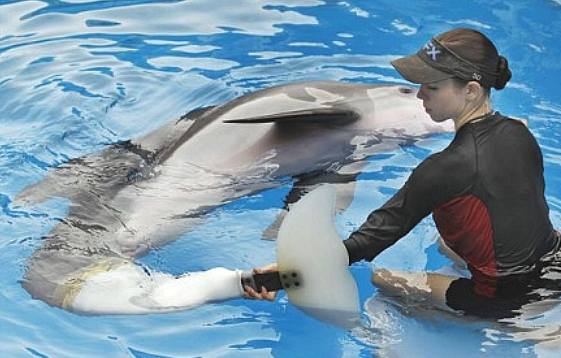
CAPTIVITY
- Dolphins in captivity is a subject that generates much controversy. The
problem here is that these marine mammals are attracted to humans. The
same applies to killer whales, they can also begin to crave human
attention. In harbours and the like this has proven fatal for the
cetaceans. Hence, such attentions should be discouraged no matter how much
you'd like to say hello.
Domestication
of animals by humans has been going on for thousands of years. We have pet
dogs and cats that are not kept for food. This kind of symbiotic
arrangement is not life threatening. The best example of a pet that is not
totally dependent on humans when it is adopted is a cat. If not cared for
a cat will simply move on.
SEPTEMBER
2011 FLORIDA - CLEARWATER AQUARIUM
Patiently nursed back to health by a Florida aquarium, it still shed its wounded tail a few days after being found - and seemed it might never be able to recover the ability to swim.
But after an unprecedented effort by doctors, staff and volunteers at the Clearwater Marine Aquarium, a rehabilitation facility for sick and injured sea life, the dolphin - by now named Winter - was fitted with a unique artificial tail and taught to swim again.
For the past six years the story has captivated thousands of visitors to the aquarium, and been the inspiration to some who were themselves grappling with the challenge of an artificial arm or leg.
Now it has been made into a Hollywood
film, starring Morgan
Freeman, to be released in the US this week and in Britain next month, in the hope that the heart-warming story will similarly enchant millions.
"So many people said the tail's never going to work, that it's a waste of time," said Kevin Carroll, who designed it. "There were a lot of naysayers. But not only did it work for Winter, there are children out there walking today who would not be walking if it was not for this dolphin."
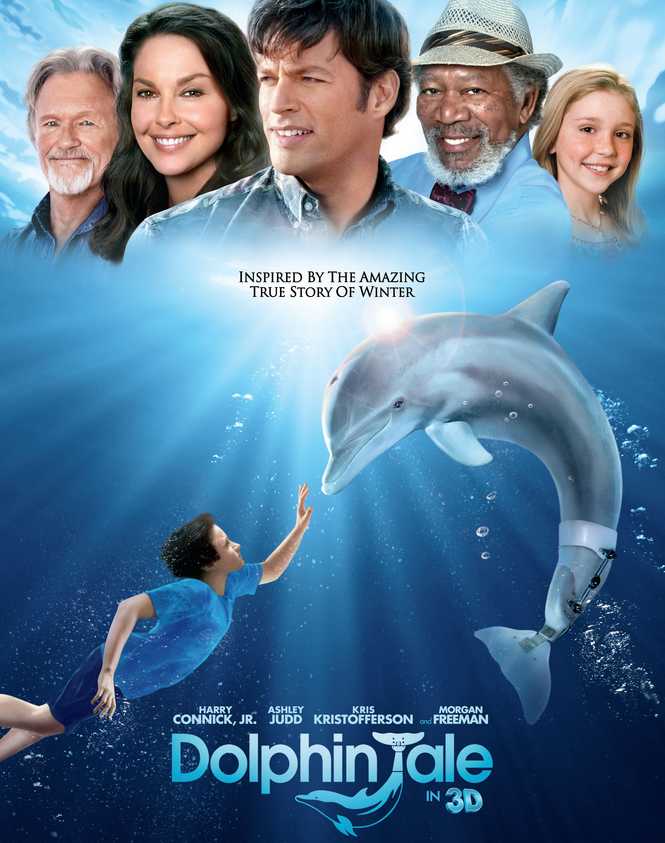
DOLPHIN
TALE STUNT DOUBLE JULY 2012
Winter, is the bottlenose dolphin that became tightly trapped in a crab trap line in 2006 when she was
just three months old, and lost her tail. She was rescued by the Clearwater Marine Aquarium (CMA) from Mosquito Lagoon near Cape Canaveral, Fla., and ultimately fitted with a prosthetic tail and made the star of the 2011 movie "Dolphin Tale."
You might not know about Winter's robotic stand-in and how it was controlled by servo-like stepper motors, drives and software.
"A robotic dolphin was needed as a stand-in for Winter in sequences which would either be too dangerous or difficult, or which could exhaust the recovering dolphin," explained QuickSilver's engineers. "KNB needed to mimic the size, coloration and water retention of the real dolphin in addition to mimicking the fluid motions. As the movie needed shots both in the water and at the surface of the water, a full-scale dolphin robot with internal electronics and actuators was used."
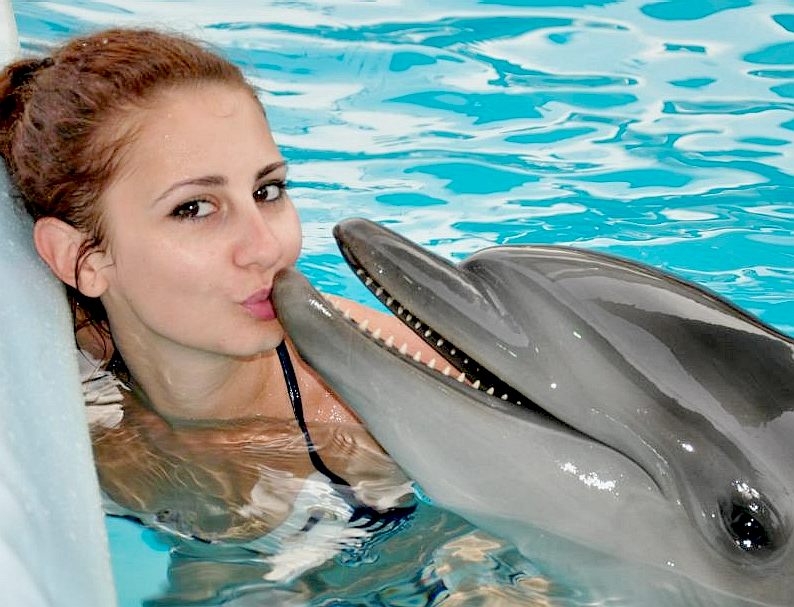
MISS
OCEAN - Monika was distressed to see this captive animal, but felt
compelled to share a few moments with it. It is hard not to interact with
a dolphin when it is so happy to see you. In the wild it is not permitted
to feed marine mammals.
The dolphin needed to operate in salt water down to about 10 m, and needed to avoid chemicals that could pollute the aquarium tank. "Multiple coordinated actuators were needed to handle the many elements needed to model the motions of an actual dolphin," the engineers said. "The motions had to be adjustable live and on-the-fly to interact with the actors during the shoot. The preferred method in the movie industry is for ‘puppet masters' to control the motions via multiple radio-controlled, multi-axis control heads. Preprogrammed motions are avoided to prevent downtime for programming between shots, which would waste expensive time with actors and film crew waiting. As the dolphin needed to operate under salt water, the normal radio link was substituted with a small wire carrying the same multiplexed signals."
The mechanical spine and muscles of the robot dolphin were implemented using several aluminum disks linked together using sets of pivots along the center line with pairs of waterproof linear actuators providing the ability to flex up and down and side to side. The linear actuators were specialty products from Ultra Motion, driven by low-voltage stepper motors. Internal, sealed potentiometers provided absolute position feedback.
Where QuickSilver motion controllers were used to close the loop, the motor velocity was commanded using a simple control loop, comparing the potentiometer feedback to the commanded signal. The gains were tuned down to smooth out the motions from the R/C controller. A second processing thread on the controller was used to monitor and recover from jams in the open-loop step motor.
To meet the filming schedule, QuickSilver added the ability to use R/C 1–2 ms control pulses as a standard option.
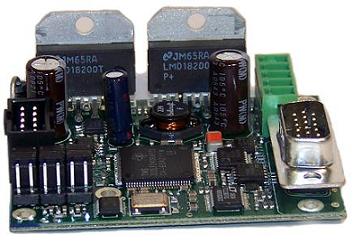
QUICKSILVER
CONTROLS - WINTER'S
TALE 2012
QuickSilver Controls, Inc. was contacted by KNB EFX Group for motion control help with a fast turn project
(reportedly 72 hours) a Robotic Dolphin for a recently released movie about Winter, a dolphin injured in crab nets who lost her tail and was helped to survive by means of a prosthetic tail.
A Robotic Dolphin was needed as a stand-in for Winter in sequences which would either be too dangerous or difficult, or which could exhaust the recovering dolphin. KNB needed to mimic the size, coloration, and water retention of the real dolphin in addition to mimicking the fluid motions. As the movie needed shots both in the water and at the surface of the water, a full scale dolphin robot with internal electronics and actuators was used. This would eliminate the strings often used with puppets, which would be harder to process out due to their effect on the water surface.
The dolphin needed to operate in salt water up to a depth of approximately 10 meters. It needed to avoid chemicals which could pollute the aquarium tank, or hurt either the real dolphin or the actors in the water. Multiple coordinated actuators were needed to handle the many elements needed to model the motions of an actual dolphin. The motions needed to be able to be adjusted live - on-the-fly - to interact with the actors during the shoot. The preferred method in the movie industry is for the “puppet masters” to control the motions via multiple sophisticated radio control (R/C) multiaxis control heads.
Preprogrammed motions are avoided to prevent downtime for programming between shots which would waste expensive time with actors and film crew waiting. As the dolphin needed to operate under salt water, the normal radio link was substituted with small wire carrying the same multiplexed signals.
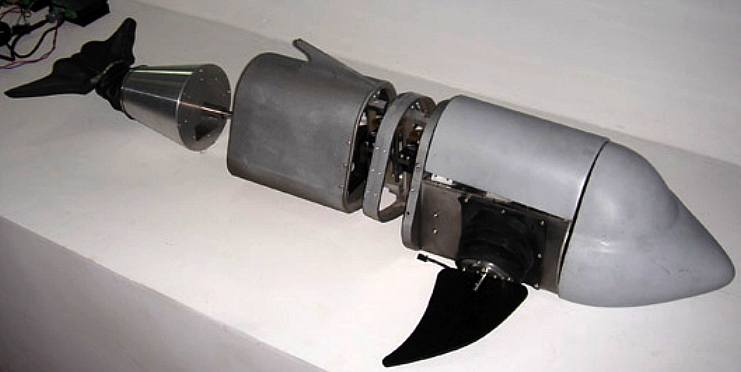
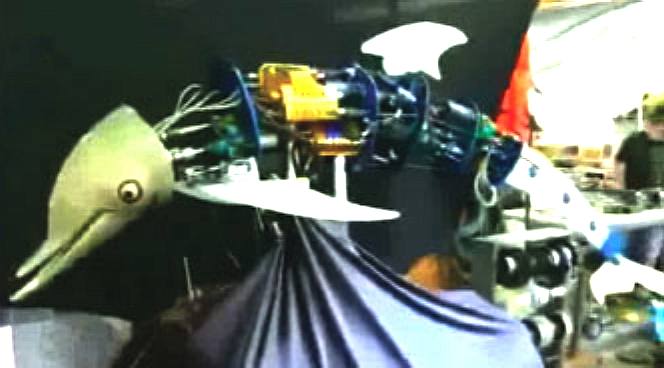
The mechanical spine and muscles of the dolphin were implemented using several
aluminum disks linked together using sets of pivots along the center line with pairs of water proof linear actuators providing the ability to flex up and down (axis working together) and side to side (actuators working differentially). The linear actuators were specialty products from Ultra Motion LLC, which were driven by low voltage stepper motors for safety reasons in a conductive saltwater environment. Absolute position feedback was provided by internal, sealed potentiometers. The
electronics were made waterproof by mounting the
circuit boards into custom sealed cases which were filled with vegetable oil, with a small amount of dried rice added as a desiccant. The food grade products were used instead of the normal mineral oil and silica gel to prevent any chance of pollution of the aquarium tank by harmful chemicals in the case of a leak.
QuickSilver Controls QCI-D2-MG-01 motion controllers were to close the loop around these open loop steppers using the potentiometer. The preferred method would have been to include motor shaft feedback to allow the motor to be commutated for higher performance, but the lead-time of the specialty underwater actuators prevented that level of customization. Instead, the motor velocity was commanded using a simple control loop comparing the potentiometer feedback to the commanded signal. The gains were tuned down to smooth out the motions from the R/C controller which only updates about 30 times per second. A second processing thread on the controller was used to monitor for and recover from jams in the open loop step motor.
The initial interface between the RC control signals and the controller had been done using small linear potentiometers mechanically connected to standard RC servo actuators. These added complexity and fragility to a system that needed to operate underwater. In order to meet schedule for the filming, QuickSilver added the ability to use standard R/C 1-2 millisecond control pulses (shown on the right) as a now standard option. This capability was added in less than 1 day in order to keep the project on schedule, allowing the pulse width signal from the receiver to directly control the
motion.

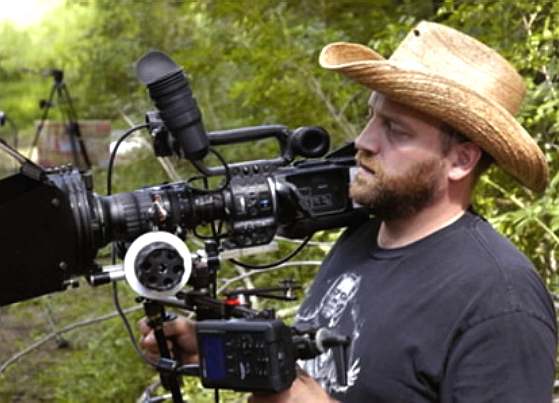

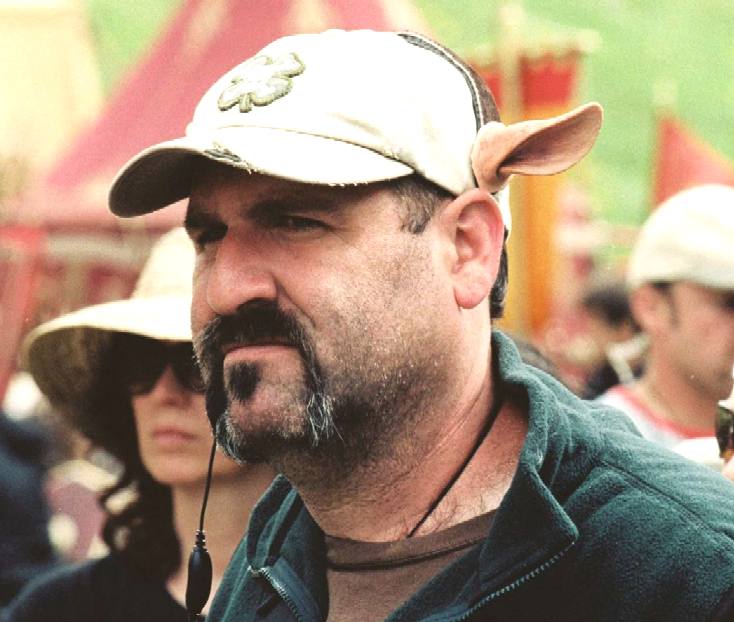

KNB
EFX GROUP - ROBERT KURTZMAN, GREGORY NICOTERO & HOWARD BERGER
Kurtzman began his career in 1984 when he moved from his hometown of Crestline, Ohio, to Hollywood,
California, to pursue his interest in special
effects where he met up with Gregory Nicotero and Howard Berger, who in
1988 formed the K.N.B. EFX Group. K.N.B. has won numerous awards, including an Emmy Award in 2001 for their work on the 2000 Sci Fi Channel miniseries Frank Herbert's Dune.
KNB EFX were awarded an Academy Award in 2006 for achievement in makeup for The Chronicles of Narnia: The
Lion, the Witch and the Wardrobe.
In 2002, Kurtzman left K.N.B. EFX
Group, relocating to Crestline, Ohio, where he co-founded the production
company: Precinct 13 Entertainment (2003). Precinct 13 is described as a Film/Television and Radio Commercial/Visual Effects production facility.
Kurtzman and P13 have recently co-produced the supernatural film The Dead Matter, featuring Andrew Divoff, Tom Savini, and Jim O'Rear.
Since forming the KNB EFX Group in
1988 they are becoming virtually the go-to guys for film and TV productions looking for the very best in special make-up effects, character prosthetics, animatronics and creature design. The Group has some 800 credits to its name including movies such as Minority Report, Kill Bill, Django Unchained, The Mist and Predators and currently TV hits Breaking Bad and The Walking Dead.
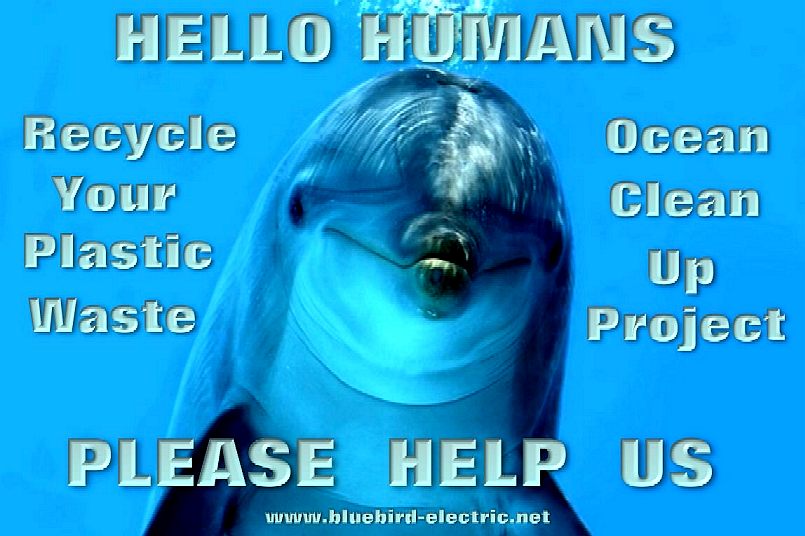
IF
ONLY THEY COULD SPEAK FOR THEMSELVES
LINKS
& REFERENCE
http://www.takepart.com/thecove
http://www.takepart.com/thecove
http://www.knbefxgroup.com/
http://www.telegraph.co.uk/earth/wildlife/8771139/Hollywood-ending-for-dolphins-tale.html
www.seewinter.com
http://www.quicksilvercontrols.com/2011_RoboticDolphin.html
http://www.seewinter.com/winter
http://www.seewinter.com/winter
http://www.navaldrones.com/seafox.html
http://www.huffingtonpost.co.uk/2012/11/08/us-navy-mine-hunting-dolphins_n_2092509.html
http://www.miltechmag.com/2013/08/auvsi-2013-unmanned-naval-systems.html
Gawker
job+stealing-robots-are-going-after-the-navys-mine+hunting-dolphins
Quicksilver
Controls 2011_Robotic Dolphin
Independent
Robots to replace navys minehunting dolphins
The
Guardian 2012 US military replace dolphins robots
RUVR
2013 Ukrainian-military-dolphins-go-missing
http://gawker.com/5964980/those-job+stealing-robots-are-going-after-the-navys-mine+hunting-dolphins
http://www.quicksilvercontrols.com/2011_RoboticDolphin.html
http://www.independent.co.uk/news/world/americas/robots-to-replace-navys-minehunting-dolphins-8374242.html
http://www.theguardian.com/world/2012/dec/02/us-military-replace-dolphins-robots
http://ruvr.co.uk/2013_03_12/Ukrainian-military-dolphins-go-missing/
http://www.guns.com/2013/03/12/ukrainian-military-dolphins-armed-with-guns-on-the-loose/
http://www.wired.co.uk/news/archive/2012-12/03/dolphin-bomb-disposal
http://now.msn.com/navy-dolphins-find-rare-19th-century-torpedo-off-california-coast
http://www.theguardian.com/world/2012/dec/02/us-military-replace-dolphins-robots
http://en.wikipedia.org/wiki/Talisman_UUV
http://www.theengineer.co.uk/in-depth/mine-busters/299583.article
http://www.history.navy.mil/wars/korea/minewar.htm
http://www.time.com/time/magazine/article/0,9171,926817,00.html
The_Corfu_Channel_Case_(UK_v._People_Republic_of_Albania)
http://en.wikipedia.org/wiki/Admiralty_Mining_Establishment
http://www.controldesign.com/industrynews/2012/robotic-dolphin-stunt-double-uses-servo-like-steppers/
http://en.wikipedia.org/wiki/Naval_mine
http://www.enterprise-europe-scotland.com/sct/news/?newsid=4306
|
Robot
& Dolphin Jet
- Youtube
|

A
heartwarming adventure: pirate whalers
V conservationists
with
a $Billion dollars riding on the conclusion.
ACIDIFICATION
- ADRIATIC
- ARCTIC
- ATLANTIC - BALTIC
- BERING
- CARIBBEAN - CORAL - EAST
CHINA
ENGLISH CH
-
GOC - GULF
MEXICO
- INDIAN
-
IRC - MEDITERRANEAN -
NORTH SEA - PACIFIC
- PERSIAN GULF - SEA
JAPAN
STH
CHINA - PLASTIC
- PLANKTON - PLASTIC
OCEANS - SEA
LEVEL RISE - UNCLOS
- UNEP
WOC
- WWF
DINOSAURS
- DOLPHINS
- HUMANOIDS
- RAYS
- SHARKS
- WHALES
|










